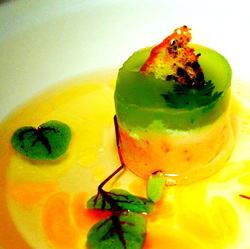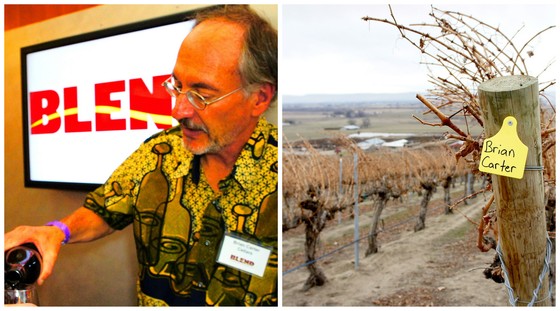Brian Carter at Blend this weekend; Carter's vines at Upland Vinyeards in February
The theory (are you listening, Mittens?) is that the diversity is stronger than single-mindedness. Several, if not many, especially when it comes to wine. More than one, at any rate.
Outside of the United States, for example, there's hardly a winery that releases a wine made entirely from cabernet sauvignon. The notion that a wine must be 100 percent pinot noir, for example, comes from Burgundy, where there simply are no other grapes around, and pinot noir by itself is nigh onto perfect. But in Bordeaux, the wilder side of cabernet sauvignon needs to be subdued with merlot, then given some backbone with cabernet franc and maybe a little perfume with petit verdot if you've got a few vines in a corner of your vineyards. Those complex and vaunted "Bordeaux blends," much drooled over, are often nothing more than combinations of whatever your grandfather's grandfather happened to plant on the land around your farmhouse.
Well, nowadays it's all much more complicated. The learned savants at the University of California at Davis, waving graphs of "degree days" in the hinterlands of the Napa Valley, decreed what would grow best in this vale or on that hillock, and the earnest technicians they sent forth from the Fermentation Science labs dutifully planted what they were told. As a result, we've had two generations now of misguided wine-growing user manuals.
Fortunately, fortunately, common sense sometimes rears its head.
 One example was an even this weekend called BLEND, which brought together some three dozen local wineries. Eight properties managed by Columbia Hospitality were on hand to showcase offerings by their chefs (seafood ceviche from host facility Bell Habor; a molded prawn appetizer from Salish Lodge, photo on the left; bison tri-tip from Rainbow Ranch in Montana; smoked salmon slider from Kitsap Conference Center). Promotional benefits aside, the educational value was provided by half a dozen wineries who revealed the secrets of their signature wine blends.
One example was an even this weekend called BLEND, which brought together some three dozen local wineries. Eight properties managed by Columbia Hospitality were on hand to showcase offerings by their chefs (seafood ceviche from host facility Bell Habor; a molded prawn appetizer from Salish Lodge, photo on the left; bison tri-tip from Rainbow Ranch in Montana; smoked salmon slider from Kitsap Conference Center). Promotional benefits aside, the educational value was provided by half a dozen wineries who revealed the secrets of their signature wine blends.
Among them was Brian Carter, the acknowledged master of blending wine in Washington. With the modesty of a teenage Mozart sitting at the keyboard in the court of Franz Josef, Carter demonstrated his inherent understanding of a wine's components: sangiovese grapes from Dick Boushey's vineyard in the heart of the Yakima Valley; cabernet sauvignon from Upland Vineyards on Snipes Mountain; syrah from Olsen Vineyards outside of Prosser. What to do with them?
In Tuscany, where sangiovese is ubuquitous, there's not much you can do except make Chianti, if you're fortunate enough to own vineyards in the designated zones. (You're welcome to call it Sangiovese outside the boundaries, however.) The trouble with sangiovese, though, and we're hardly the first to mention it, is that it's a nice wine that needs more backbone. Not an issue with wines from vineyards designated Chianti Classico DOCG, not a problem with the long-aged Riservas, not a problem with Vino Nobile di Montepulciano, nor with Brunello di Montalcino, but these famous bottles represent a small fraction of sangiovese produced in Tuscany.
Rather than ignore or challenge the laws governing wine labelling, a handful of ambitious Tuscan growers found a way around them. For those sangiovese wines that didn't have the advantage of being born into the right vineyards, they beefed them up. Not with cheap, strong juice from Sicily but with honest, locally grown cabernet sauvignon and syrah wines. And--this is the best part--rather than "declassify" their blends, they convinced a gaggle of international wine writers to give them a new name: "Super Tuscan."
It helped that A-list producers like Gaja and Antinori were leading the way. Before long, SuperTuscan became its own category, and with good reason. The cabernet and syrah did in fact help most sangiovese: it became more robust, more age-worthy, more balanced.
And that's what Brian Carter showed the folks who turned out for Blend: that the whole can indeed be greater than the sum of its parts. Carter's SuperTuscan is called TuttoRosso; the final blend was two thirds sangiovese. He bottled a thousand cases, and sells it for $30 a bottle.
In addition to an intuitive feel for what the grapes are telling him, Carter understands a fundamental principle of wine marketing: you can't push wine through the distribution pipeline. It has to get sucked out, a bottle or two at a time. The TuttoRosso might well be "worth" $100 a bottle, but the number of people who suck on $100 bottles is limited. Better by far to position it at an accessible price.
Carter does this with all his wines, all blends that allow him to select the best available grapes. In addition to the TuttoRosso SuperTuscan blend, there's a white, Oriana (viognier with roussanne topped off with a touch of riesling), Solesce (traditional Bordeaux varieties) and Le Coursier (right-bank, no cabernet sauvignon), Byzance (a southern Rhone blend), Trentenaire (mostly petit verdot) Corrida (Spanish varieties), Opulento (port-style dessert wine) and my personal favorite, Abracadabra (a "magic" blend of syrah, cabernet sauvignon, cabernet franc, sangiovese, petit verdot, grenache and malbec).
Thanks to Peha Promotions, which provided Cornichon with media access to the event.

Leave a comment